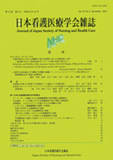Japanese
English
- 有料閲覧
- Abstract 文献概要
- 参考文献 Reference
- サイト内被引用 Cited by
要旨
介護職と看護職の連携および離職予防に必要な組織運営や人的資源のマネジメントに関する示唆を得ることを目的に、介護職と看護職の組織コミットメントとコンフリクト対処方略が職務継続意思に及ぼす影響と関連要因を明らかにした。対象は、全国の介護老人福祉施設から多段無作為抽出した400施設の常勤の介護職と看護職3名ずつ、計2,400名のうち、郵送法による無記名自記式質問紙法で回答が得られた608名(回収率25%)で、分析対象は、介護職316名と看護職250名(計566名、有効回答率93%)であった。職務継続意思は、現在の職場での仕事を継続する意思(以下「職場継続意思」)、介護もしくは看護の職業を継続する意思(以下「職業継続意思」)、現在の職場で、現在の職業を継続する意思(以下「職場・職業継続意思」)の3種類に分類した。
両職種ともこの3種類の職務継続意思すべてに有意に影響を与えていたのは情動的コミット得点の高い者(OR=1.12〜1.33)であり、「職場継続意思」に対しては継続的コミットメントの高い者であった(OR=1.10〜1.13)。
介護職で、有意項目として抽出されたのは、施設長の職種が社会福祉職(OR=1.96)、対人コンフリクト相互妥協スタイル得点(OR=0.82)、他職種カンファレンスの頻度5回/月以上(OR=0.43)、医療機関の連携病院が同一経営主体(OR=0.36)、正規職員(OR=0.12〜0.18)などが、看護職では、女性(OR=4.86)、過去の職歴が技術・専門職(OR=0.33〜0.43)や営業・販売・サービス業(OR=0.31)などであった。以上より、職種の背景を考慮した連携体制の構築や離職予防のための組織化に関するマネジメントのあり方について、コンフリクト対処方略やサポート体制の視点から検討した。
Abstract
This study aimed to obtain suggestions for organizational management and human resource management to improve collaboration between care and nursing personnel and prevent turnover. Therefore, this study examined how the organizational commitment and conflict coping strategies of care and nursing personnel affect their intention to continue to work in welfare facilities for the elderly requiring long-term care. Questionnaire surveys were sent to 2,400 people, comprising three care workers and three nurses working full-time at 400 welfare facilities for the elderly requiring long-term care selected by multistage random sampling. Questionnaires were returned from 608 people(response rate 25%). Valid responses from 566 people(316 care workers, 250 nurses; valid response rate 93%) were subjected to analysis. The respondents' intentions to continue working were divided into the following three categories: intention to continue working in one's current workplace(intend to continue at workplace), intention to continue working in the care or nursing field(intend to continue working in occupation), and intention to continue working in one's current workplace and field(intend to continue at workplace and in occupation).
The three types of work continuation, "workplace", "occupation" and "workplace/occupation", were influenced by a high emotional commitment score(OR = 1.12-1.33) among both care and nursing personnel, while "workplace" was influenced by a high continuation commitment score(OR = 1.10-1.13). Regarding care personnel, factors that contributed significantly included the facility director participates in social welfare work(OR = 1.96), compromising style(OR = 0.82), a frequency of conferences with people in other occupations ≧5 times/month(OR = 0.43), hospitals governed by the same management body(OR = 0.36), and full-time employee(OR = 0.12-0.18). Regarding nursing personnel, factors that contributed significantly included being female (OR = 4.86), a past occupational career in technical or skilled work(OR = 0.33-0.43), and marketing/sales/service work(OR = 0.31). The present findings suggest that management methods for both establishing collaboration among personnel by taking into account their backgrounds and preventing turnover at the organization should be developed from the perspective of conflict coping strategies and support systems.
Copyright © 2014, Japan Society of Nursing and Health Care All rights reserved.


